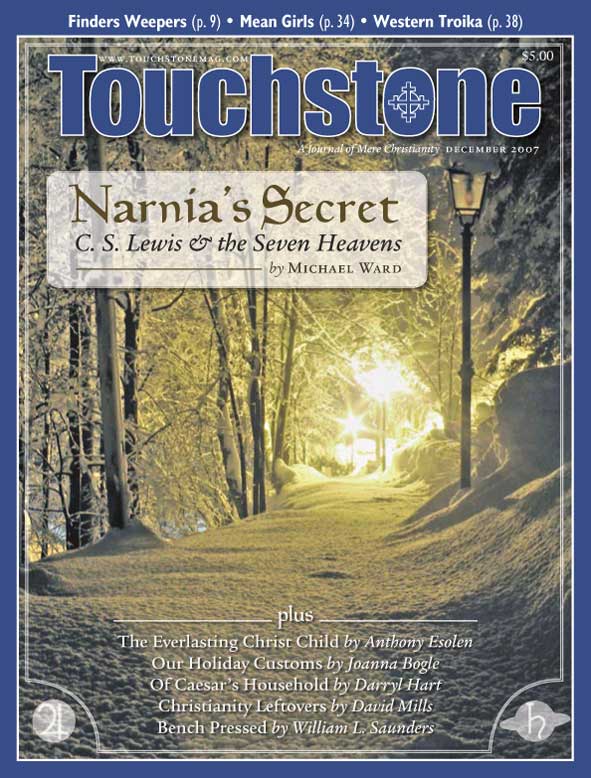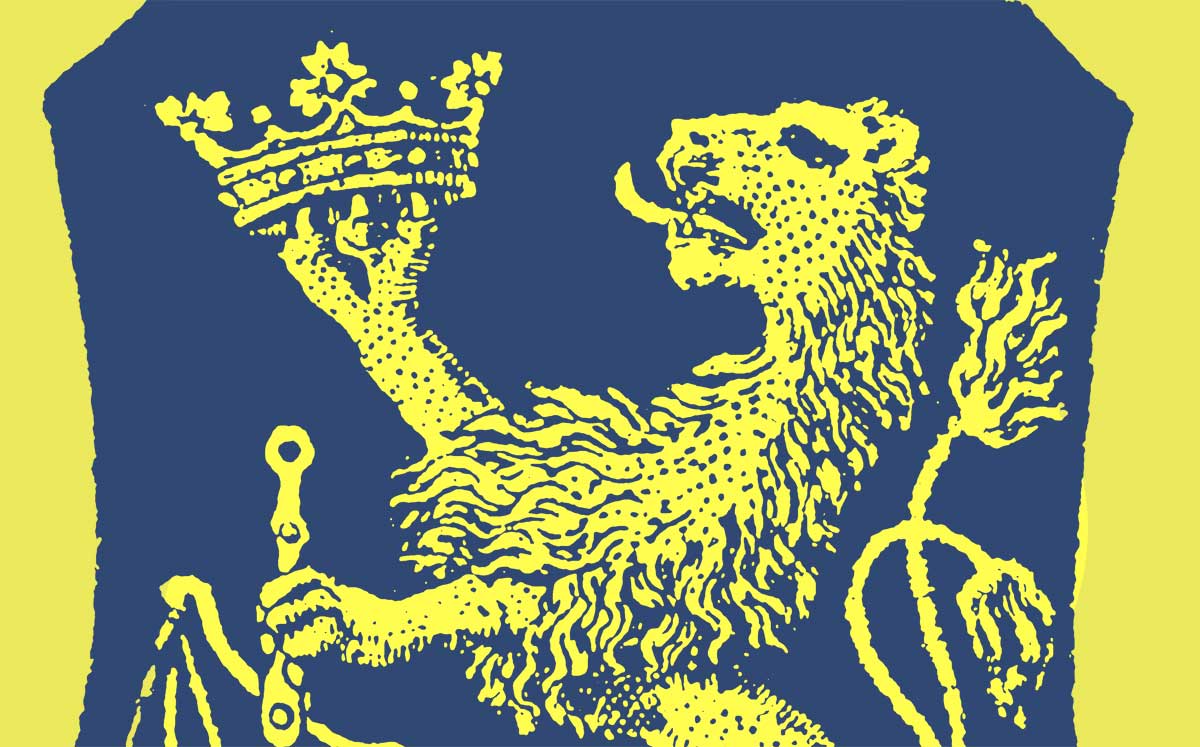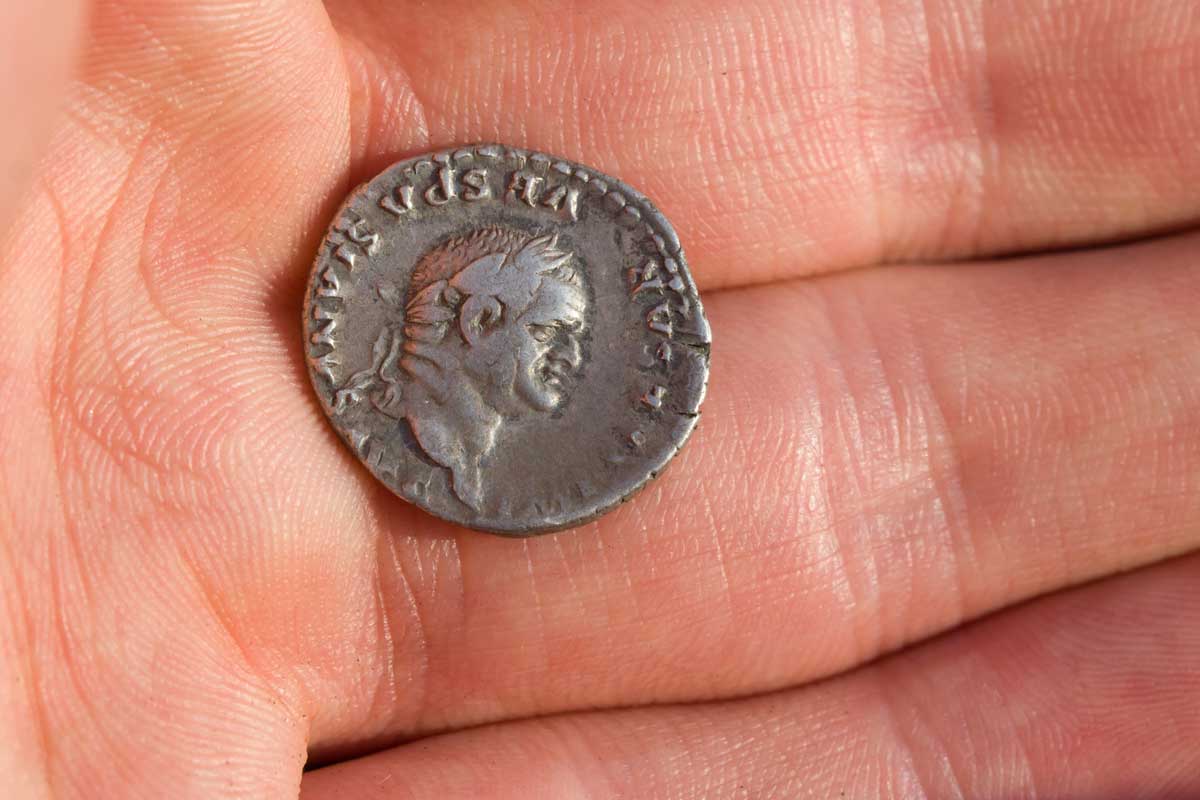Feature
Narnia's Secret
The Seven Heavens of the Chronicles Revealed
"Always winter, and never Christmas” are, perhaps, the most famous words C. S. Lewis wrote. The phrase comes four times in the opening Chronicle of Narnia, The Lion, the Witch and the Wardrobe. First, Tumnus informs Lucy of a White Witch who has made it “always winter and never Christmas.” Lucy passes on the grim news to Edmund and later Peter.
Finally, Mr. Beaver announces, in great excitement, “Didn’t I tell you that she’d made it always winter and never Christmas? Didn’t I tell you? Well, just come and see!” The reason for his excitement is that he can see in front of him a man who spells the end of the Witch’s reign:
He was a huge man in a bright red robe (bright as hollyberries) with a hood that had fur inside it and a great white beard that fell like a foamy waterfall over his chest. . . . He was so big, and so glad, and so real, that they all became quite still. They felt very glad, but also solemn.
The appearance of Father Christmas in this story has become a lightning rod for criticism of the Narnia Chronicles. It is taken as evidence of Lewis’s slapdash compositional style. Tolkien thought that Lewis had carelessly assembled figures from incompatible mythological traditions: children fresh from E. Nesbit, a Snow Queen out of Hans Andersen, dryads and naiads from classical tradition, and—forsooth!—Santa Claus from popularized hagiography.
Humphrey Carpenter, who wrote the first study of the Inklings, thought Lewis borrowed “indiscriminately” from his various sources and “threw in any incident or colouring that struck his fancy.” Lewis’s biographer A. N. Wilson described the Chronicles as a “jumble,” a “hotch-potch,” “full of inconsistencies.”
There is apparent force in these judgments, so much so that several Lewis scholars have gone looking for a hidden theme that will show the books’ underlying unity, but none has proved persuasive. Don King, for example, has argued that the series is a commentary on the seven deadly sins. Doris Myers suggests that the septet may be best understood as a miniature version of Spenser’s Faerie Queene. Jim Pietrusz links the books to the seven Catholic sacraments.
Lewis himself once said that the whole series was “about Christ.” Three of the books do reflect Christological themes: creation in The Magician’s Nephew; redemption in The Lion; judgment in The Last Battle.
The other four, however, present the Christ-like figure of Aslan in very various and non-biblical modes. He enters the story among dancing trees before giving a great war-cry in Prince Caspian; he flies in a sunbeam in The Voyage of the ‘Dawn Treader’; he is mistaken for two or possibly three lions in The Horse and His Boy; and in The Silver Chair he does not appear bodily within Narnia at all, but is confined to his own high country above the clouds.
The stories may generally be about Christ, but there seems to be no structure to the series. Perhaps Lewis had no plan. And yet one doesn’t need to have a very intimate knowledge of his mind to know that he did not work randomly.
He praised authors such as Chaucer and Spenser, who created something that “looks planless though all is planned.” And he once confided to a former pupil, Charles Wrong, that he had “an idea” he wanted to try out in the Narnia books and that he had worked it out to the full after seven volumes. This all suggests that there is more to the Narnia stories than their superficial heterogeneity led Tolkien and others to suppose.
Oblivious to the Obvious
I had never been satisfied by the notion that the Chronicles were a mish-mash, and I think I have stumbled upon their secret, governing, imaginative scheme. Let me provide three important contexts for the large claim I wish to make.
The first context is Lewis’s characteristic presentation of Christology. When he thought of Christ, he typically thought of him not as something “out there” in Nature or “up there” in Heaven or “back there” in History or “in there” in the Bible and the Eucharist.
Lewis typically thought of Christ (in the words of Colossians 1:17) as the one “in whom all things hold together.” He paraphrased that verse in Miracles, rendering it thus: “Christ is the all-pervasive principle of concretion or cohesion whereby the universe holds together.”
The universe included Lewis himself and his own understanding of Christ. His very thoughts about Christ were themselves held together by Christ. He could not in that sense step outside Christ and look at him as if from some external spectator’s point of view. And this put him, as it puts all of us, into something of a predicament, which he expressed in Miracles:
The fact which is in one respect the most obvious and primary fact, and through which alone you have access to all the other facts, may be precisely the one that is most easily forgotten—forgotten not because it is so remote or abstruse but because it is so near and so obvious. And that is exactly how the Supernatural has been forgotten.
Throughout his writings, Lewis points out this natural human tendency to be oblivious to the obvious. In Mere Christianity he writes: “Since that [divine] power, if it exists, would not be one of the observed facts but a reality which makes them, no mere observation of the facts can find it.” In Letters to Malcolm he writes: “We may ignore, but we can nowhere evade, the presence of God. The world is crowded with Him. He walks everywhere incognito.”
Lewis’s belief in the “overlookability” of God should be kept in mind when we consider the apparent planlessness of the Narnia Chronicles.
The Cryptic Element
The second context for a proper reading of the Chronicles has to do, not with theology, but with literature. In 1940, at a literary society in Oxford, Lewis read a paper entitled “The Kappa Element in Romance.” (“Kappa” is the initial letter of the Greek word meaning “cryptic” or “hidden.”)
The thrust of the paper was this: Stories are most valuable for their quality or atmosphere, not simply their plot. The example he uses is The Last of the Mohicans.
When the hero of the story is half-sleeping by his bivouac fire in the woods while a Redskin with a tomahawk is silently creeping up on him from behind, what makes for the essence of the scene is not simply peril, but the whole world to which this kind of peril belongs: the snow and snow-shoes, the canoes, the wigwams, the feathered headdresses, the war-paint, the Hiawatha names. A crook with a revolver would have conveyed a significantly different experience to the reader, even though the danger he represented might have been greater.
Stories earn our allegiance, Lewis argues, by conveying a distinct and coherent qualitative atmosphere. “To be stories at all,” he says in “On Stories,” stories
must be series of events: but it must be understood that this series—the plot, as we call it—is only really a net whereby to catch something else. The real theme may be, and perhaps usually is, something that has no sequence in it, something other than a process and much more like a state or a quality.
James Fenimore Cooper gives us the state or quality of “redskinnery.” Alexandre Dumas in The Three Musketeers gives us no such intrinsic atmosphere or spirit. His story is just plot, without any kappa element, and to that extent is, in Lewis’s view, a failure. We should remember his criteria of success and failure when approaching the Chronicles.
The third and final context for their proper reading has to do with yet another kind of hiddenness. Lewis thought that a poet could take various approaches when attempting a high religious theme. One particular approach he calls “transferred classicism.” Here God is disguised, in some degree, as a mere god.
Chief exponents of this “classicized Christian or Christianized classical work” are Milton and Tasso. Chaucer, Sidney, Spenser, and others adopt similar tactics: “The gods are God incognito and everyone is in the secret. Paganism is the religion of poetry through which the author can express, at any moment, just so much or so little of his real religion as his art requires.”
The Seven Heavens
In the context of the “overlookability” of God, the necessity of atmosphere to successful story-telling, and the usefulness of the pagan gods, let us now turn to the Narnia tales and attempt to see how they hold together.
Far from being a hotch-potch, they are, I think, held together as a unified work by Lewis’s use of one particular class of gods: the gods of the seven heavens of medieval cosmology. He had a lifelong fascination with these planetary deities and a very high view of their symbolic value. In 1935 he wrote, in a paper titled “The Alliterative Metre”:
The characters of the planets, as conceived by medieval astrology, seem to me to have a permanent value as spiritual symbols—to provide a Phänomenologie des Geistes which is specially worth while in our own generation. Of Saturn we know more than enough. But who does not need to be reminded of Jove?
Let us look quickly (we do not have room for a full treatment) at the god who provides the kappa element of The Lion, the Witch and the Wardrobe. Jupiter (or Jove) was Lewis’s favorite planet. Jupiter was “the king,” the best planet, Fortuna Major:
The character he produces in men would now be very imperfectly expressed by the word “jovial,” and is not very easy to grasp. . . . We may say that it is Kingly; but we must think of a King at peace, enthroned, taking his leisure, serene. . . . In Dante wise and just princes go to his sphere when they die.
In Lewis’s view, too much of the literature of the early twentieth century was “Saturnocentric,” that is, focused upon Saturn, the worst planet, Infortuna Major. Looking about him, Lewis saw an obsession with wastelands, killing fields, broken images, and false promises—and this was understandable, because his own generation, the generation that was mown down in the Flanders fields, had been (as he put it) “born under Saturn.”
However, that was a historical accident, not an eternal truth about the nature of the universe. The “wisdom that dominates the stars” is Jovial, and not to attempt to reach it, he thought, was pusillanimous.
In addition to being the wise and kingly planet, Jupiter is also the conqueror of winter. It was “under festal Jove” that Chaucer had written his poetry, Lewis contended, Jupiter who brings about “desires fulfilled and winter overgone.”
In That Hideous Strength, Ransom, the hero, having become a human personification of Jove, defeats his enemies, who have names such as Frost, Wither, Stone, Steele, and Winter; and in that same book, the planet Jupiter (“Glund” as Lewis calls it) comes down to earth and “overmatches” the “unendurable cold” of Saturn. In his long alliterative poem “The Planets” he wrote this about Jove:
Of wrath ended
And woes mended, of winter passed
And guilt forgiven, and good fortune
Jove is master . . .
The Bleeding Planet
“Winter passed, and guilt forgiven.” This phrase seems to provide an intriguingly neat summary of The Lion, the Witch and the Wardrobe: The White Witch’s spell to make it “always winter” spectacularly fails, and Edmund’s guilt is forgiven. How, though, is it forgiven? Through the sacrificial death of Aslan, which is also, intriguingly, “Jovial.”
In the same year Lewis wrote The Lion, he published Arthurian Torso, his study of Charles Williams’s poetry, where he analyzes a poem from The Region of the Summer Stars in which Williams had written, with characteristic density, “Pelles bleeds/ below Jupiter’s red-pierced planet.” About this mysterious image Lewis comments as follows:
Williams assumes that the huge reddish spot which astronomers observe on the surface of Jupiter is a wound and the redness is that of blood. Jupiter, the planet of Kingship, thus wounded becomes, like the wounded King Pelles [from Arthurian myth], another ectype of the Divine King wounded on Calvary.
Understood in this light, Aslan’s Calvary-like death on the Stone Table seems as capable of a Jovial construction as does the passing of winter and the forgiving of Edmund’s guilt. It should encourage us to look at the first Chronicle for other indications of Jove.
Jovial kingliness is also remarkably prominent in this opening Narnia tale. First mentions are always important, and Aslan is introduced as “the King of the wood . . . the King of the Beasts . . . he isn’t safe. But he’s good. He’s the King.”
And not only is Aslan King, Peter and Edmund become kings by the end of the story; the story is really about how it happens. Edmund wants it to happen in his own way, by siding with the Witch, who has ensnared him with her declaration that she wants a boy “who would be King of Narnia after I am gone.” Eventually he realizes that she did not intend to make him King. Out of nowhere Father Christmas appears, shouting, “Long live the true King!”
The true King is Aslan, who has his own plans for the children. He shows Peter “the castle where you are to be King” and tells him, “You will be High King over all the rest.” The climax of the tale is the scene at the castle of Cair Paravel where the children are hailed, enthroned, crowned, and sceptred. Near the end of the story, Aslan declares (and the Professor later repeats it), “Once a King in Narnia, always a King in Narnia.”
By Jove
Is Joviality the kappa element of the first Narnia Chronicle? In his university lectures, Lewis described the Jovial character as “cheerful and festive; those born under Jupiter are apt to be loud-voiced and red-faced.” He would then pause and add: “It is obvious under which planet I was born!”—which always produced a laugh.
If the hidden inner meaning of The Lion is Joviality, then how appropriate to include Father Christmas: Red-faced, loud-voiced, and jolly, he is, in popular culture, the Jovial personality par excellence. And how appropriate that Peter, when he gets through the Wardrobe into Narnia, should exclaim “By Jove!”
Given the spiritual significance that Lewis attached to Jupiter and bearing in mind the various images that he associated with it, The Lion, the Witch and the Wardrobe can be seen to have been designed as a narrative embodiment of Jove. Jovial imagery is not just tacked on to the story as an afterthought; it is within the spirit of Joviality that the Narnian universe as Lewis created it in that book “holds together.”
And of course there are six other Chronicles and six other planets. Could they all match up? Indeed, they do. Prince Caspian embodies Mars; The Voyage of the ‘Dawn Treader’ the Sun; The Silver Chair the Moon; The Horse and His Boy Mercury; The Magician’s Nephew Venus; and The Last Battle Saturn (see “Planets of Narnia,” below).
Why did Lewis never tell anyone what he was up to? Surely, the fact that he nowhere in his letters or conversations mentioned this plan to anyone indicates that this reading of the Narnia books is unlikely to be correct.
But why would he have told someone? The planetary influence in each book is the kappa element, the hidden element, the atmosphere of the book; it is an image we cannot see because, like the beam of light Lewis wrote about in “Meditation in a Toolshed,” we see along it. For Lewis to disclose his imaginative plan would have been to destroy the very thing he was trying to achieve.
There would also have been sound theological reasons for keeping the plan secret. When Peter says “By Jove!” he has no idea of the significance of what he is saying. The children in The Lion, the Witch and the Wardrobe do not know that they are in a world and in a story created and sustained, so to speak, by Jupiter. Their unawareness is a reflection of our common human condition, for, as Lewis says in Miracles, God is “opaque by the very fullness of His blinding actuality.”
God is too big for us to see easily, like the large words that escape us on maps. He saves us by becoming local. The children in the story can see the incarnation of Jupiter, in the form of the Kingly, Lion-hearted Aslan, who does away with winter, bleeds for the traitor, and enthrones them at the royal castle; and that is enough.
Lewis’s thoughts about “transferred classicism,” in which God is “disguised as a god,” are also relevant to the question of secrecy. He was ingeniously reversing the normal pattern of his medieval and renaissance sources. He wrote, “In Spenser, as in Milton and many others, Jove is often Jehovah incognito.” In The Lion, the divine figure is Jove incognito.
Serious Fun
The planetary symbols (those “spiritual symbols of permanent value”) were implanted in the Narnia Chronicles as a kind of imaginative depth-charge. Lewis presumably expected that his readers would eventually spot what he was up to.
But he was not going to tell them what he was up to because he wanted to communicate to their imaginations rather than to their intellects. The characters of the planets, Lewis remarked in The Discarded Image, “need to be seized in an intuition, not built up out of concepts,” and he would not succeed in getting his readers to intuit such characters if he told them in advance what to intuit.
He once wrote, in an essay on the King James Version of the Bible, that “an influence which cannot evade our consciousness will not go very deep,” and it was a deep, subtle, poetic way of conveying the planetary spirits that he hoped to achieve in the septet, making each book in its totality carry the message he wanted to impart. Great communicator that he was, he knew the importance of making the medium the message.
As a playful man with a keen wit, he would also have wanted to keep the scheme secret for sheer fun. “How long will it take them to notice?” he may have asked himself in gleeful wonder.
“Joy,” he believed, “is the serious business of heaven,” and the delightful realization of this secret theme provokes us to ask serious questions of ourselves. If we can overlook the spiritual symbolism of seven fairy tales, how much more might we be overlooking the spiritual significance of the real world and of the Christ who upholds it?
The Chronicles, then, are indeed “about Christ,” but they are about Christ in a much more imaginatively sophisticated way than people have hitherto realized. The Narniad looks planless, but all is planned. •
“The Kappa Element in Romance” was revised and published as “On Stories,” which can be found in On Stories; “The Alliterative Metre” in Selected Literary Essays; “The Planets” in Poems.
For those interested in reading more, Dr. Ward suggests Lewis’s The Discarded Image, especially Chapter V, “The Heavens”; Dava Sorbel’s The Planets; and Eviatar Zerubavel’s The Seven Day Circle: The History and Meaning of the Week.
Star Lights
The Bible, we all know, outlaws worship of the “host of heaven” (see Deut. 4:19; 2 Kings 17:16; 23:5; Job 31:26f; Jer. 8:2; 19:13)—but it also allows that the stars have spiritual significance, which is to be respected, studied, and, indeed, acted upon.
They proclaim the glory of God, according to the nineteenth psalm, a psalm St. Paul quotes to demonstrate how the Gentiles have already heard the preaching of Christ (Rom. 10:18). The Magi who followed the Star of Bethlehem to the birthplace of Christ clearly understood this.
Throughout the Bible the stars are seen as “signs” (Gen. 1:14; Jer. 10:2; Matt. 24:29). Interpretation of these signs is depicted negatively in Isaiah (47:13) and Daniel (1:20; 2:27; 4:7; 5:7), but only because it was practiced by heathens for godless ends, not because such astrological enquiry was considered evil per se.
Influencing Planets
Often the biblical writers treat the heavenly bodies as a kind of celestial court or choir (1 Kings 22:19; Job 38:7; Ps. 148:2f), and sometimes they seem to equate the stars with angelic power. The author of Judges records, “They fought from heaven; the stars in their courses fought against Sisera” (5:20), a verse to which Lewis alludes in Out of the Silent Planet: “The stars in their courses were fighting against Weston.”
The author of the Book of Job as translated in the King James Version mentions the “sweet influences of Pleiades” (38:31). C. S. Lewis glances at this in his poem, “My Heart Is Empty,” with its line, “The heaven remembering throws sweet influence still on earth.”
Christ himself is shown in the Book of Revelation (1:16,20; 2:1) holding the seven stars in his right hand, a vision that Austin Farrer, Lewis’s close friend and an expert in apocalyptic imagery, understood to be a portrayal of Christ’s lordship over time.
In the tradition of the Church, this understanding of the significance and influence of the stars continues. No Christian theologian before the Copernican revolution denied the general theory of planetary influences. The only subject for discussion among the doctors of the Church was the extent to which the stars were resistible.
In The City of God, Augustine casts no doubt upon the fact of stellar influence but believes it can be overcome by man’s free will and the grace of God (V, 7). In the Summa, Thomas Aquinas opposes the idea that influences cause anything more than propensities or tendencies (Ia, CXV, Art. 4).
Admittedly, John of Damascus (c. 655–c. 750) wrote in his Orthodox Faith (2, 7) that “the stars do not cause anything to happen,” but Aquinas, who cites this passage in his Sentences (Book 2), explains it by arguing that the Damascene denied the possibility of planetary influence unassisted by God. John wanted to prevent idolatry, not deny the reality of influence.
Dante, in his Purgatorio (XVI, 73–81), allows that “the spheres initiate your tendencies,” but still
you have the light that shows you right from wrong,
and your Free Will, which, though it may grow faint
in its first struggles with the heavens, can still
surmount all obstacles if nurtured well.You are free subjects of a greater power,
a nobler nature that creates your mind,
and over this the spheres have no control.In the Paradiso, Dante’s pilgrim mounts up through the seven planetary realms in his ascent to God’s throne. The idea of ranked heavens is also found in the Bible, most notably in St. Paul’s being “taken up” to the third heaven in 2 Corinthians 12:2 (compare 1 Kings 8:27; Eph. 4:10).
Belief in planetary influences persists through the Renaissance, at least until Milton, where it is still quite strong.
Disenchanted Planets
With his epoch-making work, On the Revolutions of the Heavenly Spheres (1543), the Polish stargazer Nicolaus Copernicus showed that there were not seven planets and they did not go round the Earth. The Sun was the center, and it was orbited by six planets. Luna was not the closest planet, but Earth’s moon.
As a scholar of the sixteenth century, Lewis knew well the cultural consequences of the Copernican paradigm shift. His magnum opus on the literature of that century begins with a fourteen-page treatment of “the new astronomy.”
He concludes that what proved important about it was not the mere alteration in our map of space but the methodological revolution that verified it. Reducing Nature to her mathematical elements, men began treating her as a machine, rather than as a spiritual organism with her own integrity.
“Man with his new powers became rich like Midas but all that he touched had gone dead and cold,” he argued.
This process, slowly working, ensured during the next century the loss of the old mythical imagination: the conceit, and later the personified abstraction, takes its place. Later still, as a desperate attempt to bridge a gulf which begins to be found intolerable, we have the Nature poetry of the Romantics.
The disenchantment of the universe consequent upon the Copernican revolution is part of what Lewis calls the “mythology that follows in the wake of science” and is itself unscientific.
He remarks in The Abolition of Man that only “little scientists, and little unscientific followers of science” think that “the object, stripped of its qualitative properties and reduced to mere quantity, is wholly real. . . . The great minds know very well that the object, so treated, is an artificial abstraction, that something of its reality has been lost.”
Much of Lewis’s own writing about the stars was an attempt to recover something of what had been lost. “In our world, a star is a huge ball of flaming gas,” said Eustace in The Voyage of the ‘Dawn Treader’, only to be told by a wise man that “even in your world, my son, that is not what a star is, but only what it is made of.”
— Michael Ward
Planets of Narnia
If Jupiter provides the “kappa element” or hidden meaning of The Lion, the Witch and the Wardrobe, how do the other six Chronicles relate to the other six planets of medieval cosmology?
Prince Caspian: Mars. Mars is famously the god of war and this is a war story, of a civil war to drive out the usurping King Miraz. Less famously, Mars is a god of woods and forests— Mars Silvanus, as he was known. Hence the continual use of arboreal imagery and the appearance of “silvans” at the final battle, who never appear in any other Chronicle. Reepicheep is a “martial” mouse; Miraz frets over his “martial policy.” The chesspiece found at the start of the story is, naturally, a knight.
The Voyage of the ‘Dawn Treader’: the Sun. This is a story about a journey towards the rising sun. Aslan flies out of the sunbeam towards Lucy as an albatross; he appears in the room when she utters the spell to make invisible things visible; he is seen shining as if in bright sunlight, though the sun has in fact gone in, on Goldwater Island. Gold, of course, is the sun’s metal. The killing of dragons on Dragon Island is drawn from Homer’s Hymn where the sun-god Apollo is Sauroctonus, the lizard slayer. (Compare Tolkien’s villain, Sauron.)
The Silver Chair: the Moon. Aslan only appears in person in his own high country above the clouds and has to be remembered by way of signs and in dreams below in Narnia, where the air is thick. The structure of the book reflects the great lunar divide that existed in medieval cosmology between the translunary realm of certitude and the sublunary realm of confusion. The lost Prince Rilian is a “lunatic,” bound to a chair made out of the Moon’s metal, silver. The horses Coalblack and Snowflake are derived from the steeds that pull the Moon’s chariot in Spenser’s Faerie Queene.
The Horse and His Boy: Mercury. Cor and Corin are based on Castor and Pollux, the horseman and the mighty boxer of Homer’s Iliad and stellated as Gemini, The Twins, a constellation in the house of Mercury. As separated but then reunited identical twins, they represent “meeting selves, same but sundered,” as Lewis puts it in the lines about Mercury from “The Planets.” Shasta becomes a fleet-footed messenger. A Narnian lord wears a steel cap with little wings on either side of it, a clear reference to the petasus, Mercury’s hat.
The Magician’s Nephew: Venus. Venus is the fertile planet associated with laughter, motherhood, beauty, warmth, and the apple grove of the Hesperides. Hence this story of the birth of Narnia and the healing of Digory’s mother with a magic apple taken from the Western garden; hence also “the First Joke.” The wicked Jadis is what Lewis elsewhere called “Venus Infernal,” the anti-Venus; she is based on the goddess Ishtar, who was especially worshiped in Nineveh. That is why Jadis calls Charn “that great ”an allusion to Jonah 1:2; 3:2.
The Last Battle: Saturn. Aslan does not appear at all until all the characters are dead, reflecting the nature of Saturn, the planet of (apparent) ill-chance and treachery and death. Aslan is here the deus absconditus, the God who is felt only in abandonment. Father Time with his scythe is a mythological character based on Saturn. In a surviving Narnian typescript, Father Time is named “Saturn,” but Lewis amended this to “Father Time” before publication in order to keep his planetary theme more carefully hidden.
— Michael Ward
Michael Ward is Senior Research Fellow, Blackfriars Hall, University of Oxford, and Professor of Apologetics at Houston Baptist University. He is the coeditor of The Cambridge Companion to C. S. Lewis (2010).
subscription options
Order
Print/Online Subscription

Get six issues (one year) of Touchstone PLUS full online access including pdf downloads for only $39.95. That's only $3.34 per month!
Order
Online Only
Subscription

Get a one-year full-access subscription to the Touchstone online archives for only $19.95. That's only $1.66 per month!
bulk subscriptions
Order Touchstone subscriptions in bulk and save $10 per sub! Each subscription includes 6 issues of Touchstone plus full online access to touchstonemag.com—including archives, videos, and pdf downloads of recent issues for only $29.95 each! Great for churches or study groups.
Transactions will be processed on a secure server.
more on C. S. Lewis from the online archives
more from the online archives
calling all readers
Please Donate
"There are magazines worth reading but few worth saving . . . Touchstone is just such a magazine."
—Alice von Hildebrand
"Here we do not concede one square millimeter of territory to falsehood, folly, contemporary sentimentality, or fashion. We speak the truth, and let God be our judge. . . . Touchstone is the one committedly Christian conservative journal."
—Anthony Esolen, Touchstone senior editor













